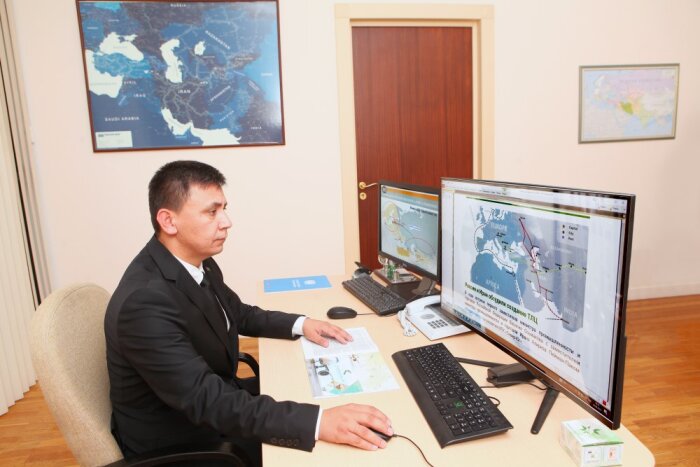 The country has an advantageous geographical location, providing prospects for promoting all modes of transport and enhancing cooperation. Perhat Charyev, a senior lecturer at the Institute of International Relations of the Ministry of Foreign Affairs of Turkmenistan, comments on the development and use of transnational transport corridors running through Turkmenistan in his interview with CentralAsia.news.
The country has an advantageous geographical location, providing prospects for promoting all modes of transport and enhancing cooperation. Perhat Charyev, a senior lecturer at the Institute of International Relations of the Ministry of Foreign Affairs of Turkmenistan, comments on the development and use of transnational transport corridors running through Turkmenistan in his interview with CentralAsia.news.
Turkmenistan’s position on strengthening regional partnerships
Currently, the key aspects of the Concept of the Foreign Policy Strategy of neutral Turkmenistan for 2022-2028 and the Programme on Transport Diplomacy of the President of Turkmenistan for 2022-2025 include the implementation of ambitious transport and transit projects jointly with the member states of the Commonwealth of Independent States and the Economic Cooperation Organization.
In October this year, speaking at the regular meeting of the CIS Council of Heads of State in Bishkek, President Serdar Berdimuhamedov announced Turkmenistan’s position on the promotion of transport and logistics partnerships among the countries of the region, «I am convinced of the relevance of the projects initiated by the Turkmen side to diversify the energy, transport and communication components of the creation of large-scale North-South and East-West infrastructure corridors for the CIS Member States. In this context, we attach great importance to building up logistics capacities with transport links in the Caspian-Black Sea and Asia-Pacific regions, as well as with the countries of the Persian Gulf and Middle East.»
In October 2019, the Declaration on Strategic Economic Cooperation of the CIS Member States, initiated by Turkmenistan, was signed at a meeting of the CIS Council of Heads of State. A logical continuation of this Declaration was the adoption of the CIS Economic Development Strategy until 2030, which envisages bolstering cooperation in the transport and communications, industry, trade, fuel and energy, innovation and technology sectors.
Transnational transport corridors across Turkmenistan
Cooperation among the CIS Member States in creating and using transnational transport corridors is growing in scale as freight and passenger traffic is increasing. The striking examples of such partnerships include the Kazakhstan-Turkmenistan-Iran railway. This international transport artery offers a short land route from Central Asia to the countries of the Persian Gulf and the Middle East, and from there to the Mediterranean and Europe and further to the countries of the Indian Ocean region.
The Kazakhstan-Iran railway is a section of the transnational route from China to the West and from Turkey to the East. Since 2016, the PRC has been carrying out freight traffic along the China-Kazakhstan-Turkmenistan-Iran route with a total length of 10,000 kilometres, supplying goods to the countries of the Persian Gulf. The average travel time from China to Iran by rail is 2 weeks, while the sea ferry route from the Port of Shanghai to Bandar Abbas Port in Iran took more than a month. Thus, saving time on cargo transportation is twice as much.
Since July 2022, container trains have been running to the Port of Nhava Sheva in Mumbai, India, along the eastern branch of the North-South corridor, along the Russia-Kazakhstan-Turkmenistan-Iran-India railway and further to other countries by sea. The total length of this route is more than 8,000 kilometres.
From Central Asia to Europe
The North-South transport corridor is capable of transporting goods to European countries. Last summer, the first freight train made its trial run along the Kazakhstan-Turkmenistan-Iran-Turkey route. It takes 12 days to cover 6,300 kilometres. Turkmenistan urges the CIS and ECO Member States to utilize the potential the Kazakhstan-Turkmenistan-Iran transport corridor in full.
Transport and logistics potential of the Caspian Sea region
The Caspian corridor has significant potential as it is the shortest and most competitive trade route between the markets of Asia and Europe. Turkmenistan is the author of important initiatives to create transport and logistics routes in Central Asia and the Caspian Sea region and give the CIS Member States access to European markets.
The Caspian Sea countries have direct access to the east — to South Asia and the Asia-Pacific region, to the west — to the Black and Mediterranean Seas, to the south — through Iran to the Near and Middle East, through Russia to the Baltic Sea coast. From China to Europe, goods are transported by rail faster than by sea — it is much more profitable than by sea, although sea freight is cheaper. According to Bloomberg, it takes 40 days to deliver a container from China to Europe, while the delivery time of a container along the Central Asia-Caspian Sea-South Caucasus route is about half a month. The Caspian transport corridor can be therefore regarded as one of the ways to increase freight movements between the West and the East, reduce prices for some goods and intensify cooperation among the Eurasian countries.
The largest transport corridors in Eurasia
These include the Afghanistan-Turkmenistan-Azerbaijan-Georgia-Turkey transnational multimodal transport and transit corridor, the Uzbekistan-Turkmenistan-Iran-Oman transport and transit project along the Central Asia-Middle East route and the Turkmenistan-Azerbaijan-Georgia-Romania transnational transport corridor along the Caspian Sea-Black Sea transport route.
Furthermore, the routes China-Kyrgyzstan-Uzbekistan-Turkmenistan-Azerbaijan-Georgia-Turkey-Europe from Southeast Asia through Central Asia, the Caucasus to Europe, Kyrgyzstan-Uzbekistan-Turkmenistan-Iran and Tajikistan-Uzbekistan-Turkmenistan-Iran-Turkey, linking the Central Asian countries with the Middle East and Asia Minor with access to the countries of the Indian Ocean region, have a significant potential.



